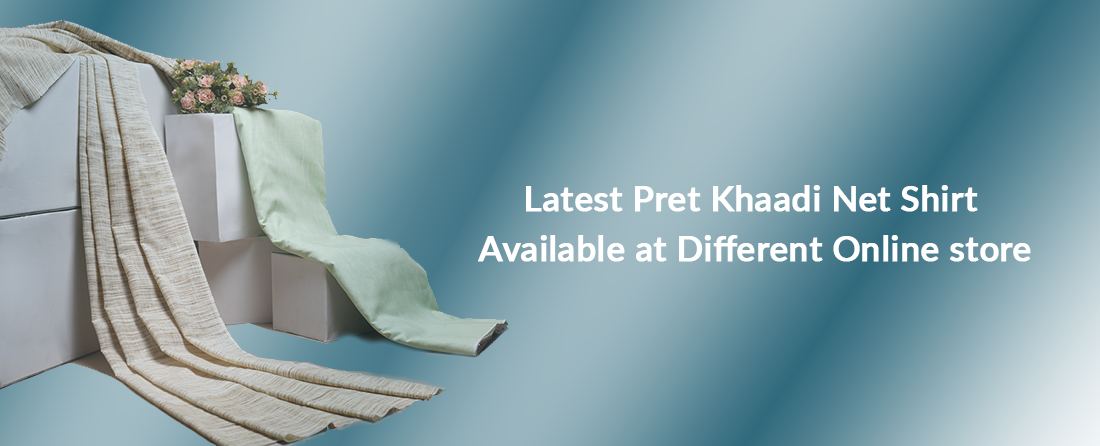Buy Stylish and Fashionable Pret Khaadi Net Shirt at RJs Pret
Introduction:
Khadi got its significance from Mahatma Gandhi jee when he revived the 4000-year-old training of hand-weaving as a part of his movement of freedom fighters in the 1930s, and approximately after eight decades of freedom Khadi continues to surprise people around the world, promoting maintainable style and setting some newest style trends.
The word pret Khaadi is a rise from ‘Khaddar’, a term used for handspun textiles in the subcontinent. Hand spinning has been well-known to the subcontinent for hundreds of years but Gandhi revived the country flagging the Khadi industry, he made the cloth the sign of all things swadeshi. He encouraged persons across the country to boycott British made fabric, spin their yarn, and attire the Khadi fabric.
Over the decade’s textile has evolved from the freedom fighter’s cloth to the unique fabric. Now, it is used to make stylish garments and some modern trends.
Here at RJs Pret, I am going to discuss the history, specifications, and different types of khaki fabric.
Properties of Pret Khaadi:
Khadi is more than a cloth, it is a method of weaving from a flower thread, and it signifies the struggle for independence. The fabric is cool, comfy, and truly environment-friendly for every season and is well famous for its rugged surface. The properties that create it stand out of the box are:
- it affords a certain kind of light weightiness in summers and warmness in winters.
- It is one such cloth that the further you wash it, the better it appearances and feels on the skin.
- the surface of the cloth is so unique that no two fabrics will be matching, which further leaves it different and fashionable in terms of feel and smoothness.
- the textile is approximately 3.26 times more energy effective than mill fabric.
Types of Pret Khaadi Available:
There are numerous varieties of Khaadi textile obtainable in the market, if separated based on the factual which has been knitted, the three main kinds are:
1. Khaadi Cotton Textile- This cloth is usually made from pure cotton yarns. Pret Khaadi fabric also has numerous variations according to the need of the clothing and style industry.
2. Khaadi Silk Textile- This cloth has 2 subtypes of textiles, the first is pure Khaadi silk which says the cloth is knitted from completely silk yarns, and the second kind includes the blending of numerous yarns. Khadi Silk with a combination of other yarns produces variations like- Makai Khadi Silk, Tussah Silk, Printed Silk, and Patty Silk.
3. Woollen Khadi Textile- Under this group Khaadi is being knitted from wool.
4. Ponder Khadi- It is rarely obtainable in today’s marketplace, it is essentially produced in the Southern region of the subcontinent. All these are particularly produced to create Khaadi sarees.
The subcontinent market has now choices of designer Khaadi Pret sarees and georgette Khaadi sarees which are well appreciated by the purchasers, but abroad the demand for pure silk cloth still tops the priorities.
“Khaadi Pret” Market, Rate, and Employment:
Get your hands on the Khaadi fashionable Spring/Summer 2020 collection and discover what the renowned designers have to say about it, “We must make sure that a part of the profits from Khaadi is diverted to Gandhian logic successfully. Therefore the percentage usage of Khaadi in designer collections must extremely increase.”
Designers look forward to fluctuating Khadi from boring to elegant, stimulating khadi’s organic nature, it’s been attractive to the e-commerce method, partnering with numerous brands, making new items and designs like pants, kinds of denim, and T-shirts for building an approximately youthful market for the cloth.
The production of Khaadi employs hundreds of rural trained artisans, 80% of them are ladies. It is an energetic source of revenue for the rural poor.
The fresh age Khaadi items in Pakistan cannot be called out low-cost, for example, painted raw silk cloth costs more than Rs/- 900 per meter, but wearing Khaadi is not just about actuality trendy and stylish but it’s more of having ethics and promoting maintainable fashion. As long as individuals are aware of the atmosphere, Khaadi will continuously hold a strong market and rate won’t be a factor.
Pros and Cons of Khaadi Pret:
Pros:
1. it is plaited in a way that it provides skin better breathability.
2. it is long-lasting and a piece of high-quality fabric.
3. it is friendly and environmental.
Cons:
1. the factuality of the textile is very coarse.
2. on a certain level it causes discomfort on the skin.
3. it shrinks.
4. it can be a petite expense.
Styling Tips with Khaadi:
Khaadi previously was deliberated to be famous only by millennials, but thanks to the wonderful designers of the Pakistan fashion industry, they made the youth also fall for the stunning textile, and improved its authenticity internationally.
Khaadi holds gorgeous properties which creates it favorable for all season, here are some of the different methods to embellish the fabric this summer-
- Georgette Khaadi saree can work beautifully well for summer days.
- One can never go incorrect with a pure Khaadi kurta, trousers along with Kolhapur chapels.
- A khaki scarf can offer your clothing a completely different fresh look.
- Khaadi trousers are something that will make you look classy yet elegant.
Conclusion:
Here at RJs Pret, I have explained pret Khaadi fabric types and Properties. Khaadi is not just an approximately random textile, it played a main part in Pakistan's independence, and today it’s creating its grandeur by setting the newest fashion tendencies along with promoting maintainable fashion.
The fresh age Khaadi items in Pakistan cannot be called out reasonable, for example, painted raw cloth costs more than Rs/- 700 per meter, but wearing Khaadi is not just about actuality trend and style but it’s more of having ethics and promoting maintainable fashion.

